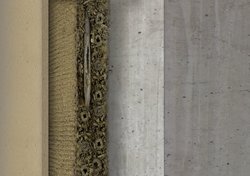Comfort and lower carbon footprint combined
In recent years, significant efforts have been made to reduce buildings’ CO2 emissions and energy consumption by making them better insulated and airtight. An unfortunate consequence of this trend, however, has been a deterioration of the indoor environment. The H-HOUSE (Healthier Life with Eco-innovative Components for Housing Constructions) project aims to overcome this problem by developing multifunctional and flexible components for the building envelope and internal walls that provide both energy efficiency and living comfort at an affordable price. Building components are being created that have lower embodied energy and a smaller carbon footprint, prevent the accumulation of pollutants, and reduce noise. They are intended for both new buildings and for renovation. Ecodesign of the solutions driven by sustainable architectural concepts and life-cycle assessment is supporting the material scientists and engineers. Starting from materials In rethinking building components, H-HOUSE first developed new materials or improved existing ones. Material development comprised earthen materials, textile reinforced concrete (TRC), foam concrete (FC), ultra-high performance concrete (UHPC) and autoclaved aerated concrete (AAC), and focused on modifying the physical and chemical properties of surfaces. Earth plasters modified with aerogels and insulation boards based on natural materials increased water vapour absorption by 40 to 80 % compared to conventional gypsum plasterboard, thus improving indoor moisture buffering. Approximately 30 natural building materials were tested in newly designed test chambers for emissions of formaldehyde, volatile organic compounds (VOCs), semi-volative organic compounds (SVOCs) and radon. Apart from one, all materials showed only limited emissions below recommended threshold values. The clinker content of the TRC and the UHPFRC – which contributes to a higher embodied energy and carbon footprint – was reduced using various cement replacement materials while retaining superior structural performance. In addition, several less energy-intensive cement types were found to be potentially good alternatives to Portland cement for the production of the AAC. A novel foam concrete was developed that has a reduced thermal conductivity thanks to lower density and the incorporation of aerogels. ‘The foam concrete we have developed has a lower density than water, and it’s inflammable so it does not release any toxic fumes in case of fire unlike most other insulation materials,’ says Prof. Katarina Malaga, project coordinator from the CBI Swedish Cement and Concrete Research Institute. Nearly impermeable self-cleaning surfaces H-HOUSE is providing functionalised concrete surfaces. By micro-structuring the concrete surface in combination with the application of water-repellent agents, researchers have made it super hydrophobic. ‘When you drop water on it, the water bounces off and eventually takes off pollutants,’ says Prof. Malaga. This effect will prevent dirt from accumulating or biological growths from forming on the surface. The Bundesanstalt für Materialforschung und –prüfung (BAM) in Germany, the surface’s developers, have applied for a patent on an innovative technique for the creation of such self-cleaning concrete surfaces. Putting it all into practice The H-HOUSE project aims not only to develop new materials, functional surfaces and innovative composite structural elements, but to ensure that they can be produced economically in practice. All the materials and composite elements will be prototyped on the industrial level to test their commercial viability and to resolve any remaining production issues. ‘Putting all the materials together is a major challenge,’ says Prof. Malaga. While detailed cost analyses are ongoing, Prof. Malaga expects a higher purchase price for several of the components to be offset by increased durability, lower maintenance costs and higher energy efficiency. Time savings in construction will benefit: ‘the insulated composite façade panels can be clicked on like lego in one step, whereas installing insulation material and then the facing is currently a two-step process’, says Prof. Malaga. H-HOUSE concludes in 2017 and consortium partners and third parties have already expressed their intention to commercialise the project results.
Keywords
CO2, H-HOUSE, composite, façade, buildings, energy efficiency, self-cleaning, concrete, building materials, VOCs, embodied energy



